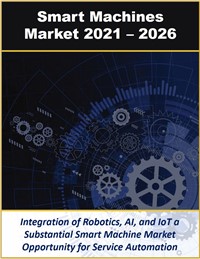This report evaluates the smart machine market ecosystem including technology building blocks, leading company strategies, products and services. The report evaluates various smart machine solutions, products, and services including autonomous robots, expert systems, intelligent assistants, neurocomputers, and wearable devices.
This report also evaluates the hardware, embedded software, and related services for smart machines. The report also assesses the market for smart machines in many industry verticals including aerospace and defense, automotive, banking, consumer electronics, healthcare, industrial automation, cybersecurity, transportation and logistics with forecasts from 2021 through 2026.
Select Research Findings:
- The global smart machine market will reach $29.9 billion by 2026
- Asia Pac will lead the smart machines market, research $11.6 billion by 2026
- Cognitive technologies in North America market will reach $1.43 billion by 2026
- Autonomous robots will reach $9.5 billion globally by 2026, growing a CAGR of 18.6%
- Neuro computing solutions for smart machines will reach $1.8 billion globally by 2026
The drivers for enterprise and industrial adoption of smart machines include improvements in the smart workplace, smart data discovery, cognitive automation, and more. Currently conceived smart machine products include autonomous robots (such as service robots), self-driving vehicles, expert systems (such as medical decision support systems), medical robots, intelligent assistants (such as automated online assistants), virtual private assistants (Siri, Google Assistant, Amazon Alexa, etc.), embedded software systems (such as machine monitoring and control systems), neurocomputers (such as purpose-built intelligent machines), and smart wearable devices.
Target Audience:
- Systems Integration Companies
- Communications Services Providers
- Automation and Robotics Companies
- Artificial Intelligence Solution Providers
- Industrial Automation Solution Providers
- Research and Development Organizations



